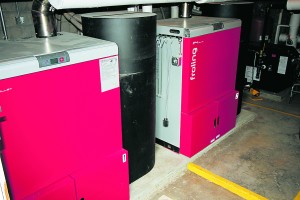By George Harvey
Lyme, New Hampshire is a town with strong local interest in renewable power. The August issue of Green Energy Times had an article on Crossroads Academy’s 40-kilowatt (kW) solar photovoltaic (PV) array. The same issue had a short article about the three communities in New Hampshire that had the greatest number of solar rebate permits, and Lyme was among them, despite its small population of only about 1700 residents. Lyme may arguably be the most solar-oriented town in the state.
Now it is time to turn to another school in Lyme, to showcase its accomplishments. The Lyme Elementary School has done a lot of work, not only on renewable electric energy, but also on both renewable heating and efficiency.
The start of any energy conservation program is identifying the most effective choices to make. Such planning should start with an energy audit, because it points out the specific steps that can be taken to produce savings. Efficiency is almost always the most important and least costly single step, but careful efficiency steps can be practically wasted, unless the whole is examined and the areas of greatest waste identified and addressed. Insulation does not help much if there is an open window.
The timing of the move toward efficiency and renewable fuel was important at the Lyme Elementary School, because it was being done just as the size of its physical school building was increasing by about a third. After studying the alternatives, the school had a new heating system installed by TARM USA. The old system, which would have been inadequate to the job of heating the school with its additional space, burned a lot of oil.
The new system consisted of two pellet boilers from Froling Energy, each rated at 350,000 BTUs. A level of efficiency is achieved by the fact that there are two biomass boilers. This means that one of them can be idle, when the temperatures outside are not very cold. The 9,000 gallons of oil previously used was replaced by eighty tons of locally produced wood pellets. A pellet silo was added to the building, and it can hold thirty tons of fuel. There is also a propane heater that can come on when the temperature is below ten degrees Fahrenheit.
The combination of efficiencies and changes in the type of fuel used saved the school about $10,000 each year, according to the principal, Jeff Valence. Additionally, the school has received some support because the switch from oil to wood made it eligible for renewable energy credits, and because it could take advantage of the New Hampshire commercial boiler rebate, which was available when the boilers were installed. The boilers also have recording meters that keep a record of how much heat they have produced. The school is eligible for thermal renewable energy credits based on the figures reported by the monitors.
Lyme Elementary school also has its own solar array to provide it with electric power. The array has a capacity of 15 kW, which reduces the dependence on the grid for electricity greatly.
One of the advantages of having a PV system is that it can be used as a basis for additions to the school’s curriculum, examining renewable power. Valence says that the school is currently examining how to integrate that. We might note that one of the great advantages of distributed power is that a class can take a field trip to the school’s own solar array, without a drop of fuel being used.










Leave a Reply